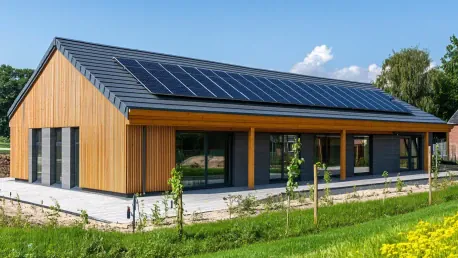Luca Calarailli is an expert in Construction, with extensive knowledge in design and architecture. He is also passionate about exploring technology applications and tools that drive innovation within the industry. We recently had the opportunity to sit down with Luca to discuss sustainable housing and green technologies in Kenya. In this interview, we explore the types of green technologies being adopted, the goals of regional forums, government policies, economic and environmental impacts, solar energy solutions, smart technologies, and the challenges and future prospects of sustainable housing.
Can you elaborate on the types of green technologies currently being adopted in Kenya for sustainable housing?
In Kenya, there’s a strong emphasis on using energy-efficient materials, such as insulated concrete forms and low-emissivity windows, which reduce energy consumption significantly. Solar panels are also widely adopted for both on-grid and off-grid applications, as they are vital in areas with limited access to electricity. Additionally, there’s a growing interest in rainwater harvesting systems and green roofs, which help manage resources sustainably.
What are the key characteristics of energy-efficient materials that set them apart from traditional ones?
Energy-efficient materials are designed to provide better insulation, reduce energy loss, and thereby decrease the need for heating and cooling. They often incorporate advanced technologies such as reflective coatings or phase-change materials that store and release thermal energy. These characteristics contribute to substantially lowering energy consumption compared to traditional materials.
How do smart home systems contribute to energy efficiency in sustainable housing projects?
Smart home systems enhance energy efficiency by allowing for automated control of lighting, heating, cooling, and appliances. Sensors and smart meters gather real-time data on energy usage, which helps homeowners make informed decisions about their consumption patterns. This automation ensures that energy is used only when necessary, significantly cutting down wastage.
What are the goals for the upcoming regional forum on sustainable housing?
The primary goal is to bring together developers, policymakers, and investors to discuss the current challenges, share innovative solutions, and create actionable plans for promoting sustainable housing. The forum aims to strengthen collaboration among stakeholders and drive forward-thinking policies that support green building practices.
Who will be the key participants at the forum, and what roles will they play?
Key participants will include developers, who bring practical insights and innovative construction techniques; policymakers, who can advocate for supportive regulations and incentives; investors, who provide the necessary funding for green projects; and experts, who contribute knowledge on the latest sustainable technologies and practices.
How vital is multi-stakeholder collaboration in overcoming the current challenges in sustainable housing?
Multi-stakeholder collaboration is absolutely crucial. The complexity of sustainable housing demands input and cooperation from various sectors. Developers, government bodies, financial institutions, and communities must work in unison to address regulatory, financial, and technical challenges effectively and ensure the successful implementation of sustainable housing projects.
What specific policies has the Kenyan government implemented to promote sustainable housing?
The Kenyan government has introduced several policies, including tax incentives for green building materials, direct subsidies for renewable energy installations, and stricter building codes aimed at improving energy efficiency. These policies are designed to lower the barriers to adopting sustainable practices and encourage more developers to build green.
How is the government supporting solar energy adoption among homeowners and developers?
The government supports solar energy adoption through initiatives such as tax exemptions on solar equipment, grants, and loan programs specifically for renewable energy projects. Additionally, there are efforts to streamline the approval process for solar installations, making it easier for homeowners and developers to go solar.
Are there any financial incentives or subsidies available for individuals or companies investing in green technologies?
Yes, there are various financial incentives, including tax rebates, grants, and low-interest loans. These incentives are designed to reduce the initial investment costs for green technologies, making them more accessible to both individuals and companies.
What are the economic benefits for homeowners who invest in energy-efficient and sustainable housing?
Homeowners can enjoy multiple economic benefits, including significantly reduced utility bills, increased property value, and potential savings on maintenance costs. Energy-efficient homes also tend to have better resale values due to their reduced operating costs and environmental benefits.
How do green technologies help in reducing the environmental impact of urbanization in Kenya?
Green technologies reduce the environmental footprint of urbanization by lowering energy consumption, minimizing waste, and reducing greenhouse gas emissions. Sustainable construction practices also emphasize the use of recycled materials and innovative designs that work harmoniously with the environment.
Can you provide data or examples of the reduction in utility costs for homes utilizing advanced technologies?
According to the Kenya Green Building Society, homes employing advanced green technologies have shown a reduction in energy consumption by up to 30%. This translates into significant savings on utility bills, often cutting household energy costs by 20-40%.
What is the current state of solar energy adoption in Kenya’s electricity generation, and how has it evolved over the years?
Solar energy adoption in Kenya is growing rapidly. Solar power currently accounts for approximately 20% of the nation’s electricity generation. Over the years, advancements in technology and decreasing costs have made solar energy more viable, leading to increased installations and usage across both urban and rural areas.
How do off-grid solar solutions benefit rural areas with limited access to the main power network?
Off-grid solar solutions provide a reliable and sustainable power source for rural areas that are not connected to the main electricity grid. These solutions give households access to electricity for lighting, cooking, and other essential activities, significantly improving living standards and economic opportunities.
Are there any notable examples of self-sustaining homes that supply surplus energy back to the grid?
Yes, some projects have successfully implemented net-zero energy homes. These homes not only meet their own energy needs through renewable sources like solar panels but also generate surplus energy that can be fed back into the grid. This surplus energy can then be used by other consumers, promoting a more sustainable energy ecosystem.
How do smart meters and automated systems improve energy management in homes?
Smart meters and automated systems improve energy management by providing detailed consumption reports and enabling automation of energy use. These technologies allow for the optimization of energy consumption patterns, ensuring that devices operate only when needed and at optimal efficiency.
What is the role of real-time data in helping homeowners make informed decisions about their utility usage?
Real-time data is vital as it offers immediate insights into energy usage patterns. Homeowners can identify areas of high consumption, track the effectiveness of their energy-saving measures, and make adjustments promptly. This data-driven approach helps in achieving significant reductions in energy use and costs.
Could you provide some insights into the potential energy savings from implementing these smart technologies?
Implementing smart technologies can lead to substantial energy savings, often reducing overall household consumption by up to 40%. For instance, automated lighting and temperature control systems ensure that energy is only used when necessary, drastically cutting down wastage and boosting efficiency.
What are the primary obstacles facing the implementation of sustainable housing in Kenya?
Major obstacles include high initial costs, limited public awareness, insufficient regulatory frameworks, and inadequate access to financing. Overcoming these challenges requires coordinated efforts to educate stakeholders, provide financial support, and enforce policies that promote sustainable practices.
How can developers and urban planners work together to address these obstacles?
Developers and urban planners can collaborate by sharing knowledge, integrating sustainable practices into urban planning from the outset, and advocating for supportive policies and incentives. Joint efforts can lead to innovative solutions that address both the financial and technical barriers to sustainable housing.
Do you have any advice for our readers?
Absolutely. My advice to readers is to stay informed about the latest sustainable technologies and consider implementing them in your own homes. Even small changes can make a significant impact on energy consumption and environmental sustainability. Always explore incentives and support provided by the government to make these technologies more accessible.









